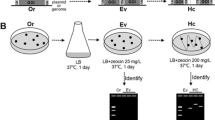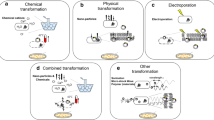Abstract
We have comprehensively analyzed the linear chromosomes of Streptomyces griseus mutants constructed and kept in our laboratory. During this study, macrorestriction analysis of AseI and DraI fragments of mutant 402-2 suggested a large chromosomal inversion. The junctions of chromosomal inversion were cloned and sequenced and compared with the corresponding target sequences in the parent strain 2247. Consequently, a transposon-involved mechanism was revealed. Namely, a transposon originally located at the left target site was replicatively transposed to the right target site in an inverted direction, which generated a second copy and at the same time caused a 2.5-Mb chromosomal inversion. The involved transposon named TnSGR was grouped into a new subfamily of the resolvase-encoding Tn3 family transposons based on its gene organization. At the end, terminal diversity of S. griseus chromosomes is discussed by comparing the sequences of strains 2247 and IFO13350.




Similar content being viewed by others
References
Bentley SD, Chater KF, Cerdeno-Tarraga AM et al (2002) Complete genome sequence of the model actinomycete Streptomyces coelicolor A3(2). Nature 417:141–147
Brown NL, Misra TK, Winnie JN, Schmidt A, Seiff M, Silver S (1986) The nucleotide sequence of the mercuric resistance operons of plasmid R100 and transposon Tn501: further evidence for mer genes which enhance the activity of the mercuric ion detoxification system. Mol Gen Genet 202:143–151
Chen CW, Huang CH, Lee HH, Tsai HH, Kirby R (2002) Once the circle has been broken: dynamics and evolution of Streptomyces chromosomes. Trends Genet 18:522–529
Delic V, Hopwood DA, Friend EJ (1970) Mutagenesis by N-methyl-N’-nitro-N-nitrosoguanidine (NTG) in Streptomyces coelicolor. Mutat Res 9:167–182
Fischer G, Decaris B, Leblond P (1997) Occurrence of deletions, associated with genetic instability in Streptomyces ambofaciens, is independent of the linearity of the chromosomal DNA. J Bacteriol 179:4553–4558
Fischer G, Wenner T, Decaris B, Leblond P (1998) Chromosomal arm replacement generates a high level of intraspecific polymorphism in the terminal inverted repeats of the linear chromosomal DNA of Streptomyces ambofaciens. Proc Natl Acad Sci USA 95:14296–14301
Goshi K, Uchida T, Lezhava A, Yamasaki M, Hiratsu K, Shinkawa H, Kinashi H (2002) Cloning and analysis of the telomere and terminal inverted repeat of the linear chromosome of Streptomyces griseus. J Bacteriol 184:3411–3415
Grindley ND (2002) The movement of Tn3-like elements: transposition and cointegrate resolution. In: Mobile DNA II, ASM Press, Washington, DC, pp 272–302
Heffron F, McCarthy BL, Ohtsubo H, Ohtsubo E (1979) DNA sequence analysis of the transposon Tn3: three genes and three sites involved in transposition of Tn3. Cell 18:1153–1163
Ikeda H, Ishikawa J, Hanamoto A, Shinose M, Kikuchi H, Shiba T, Sakaki Y, Hattori M, Omura S (2003) Complete genome sequence and comparative analysis of the industrial microorganism Streptomyces avermitilis. Nat Biotechnol 21:526–531
Inoue S, Higashiyama K, Uchida T, Hiratsu K, Kinashi H (2003) Chromosomal circularization in Streptomyces griseus by nonhomologous recombination of deletion ends. Biosci Biotechnol Biochem 67:1101–1108
Ishikawa J, Hotta K (1999) FramePlot: a new implementation of the frame analysis for predicting protein-coding regions in bacterial DNA with a high G + C content. FEMS Microbiol Lett 174:251–253
Kameoka D, Lezhava A, Zenitani H, Hiratsu K, Kawamoto M, Goshi K, Inada K, Shinkawa H, Kinashi H (1999) Analysis of fusion junctions of circularized chromosomes in Streptomyces griseus. J Bacteriol 181:5711–5717
Kinashi H (2008) Antibiotic production, linear plasmids and linear chromosomes in Streptomyces. Actinomycetol 22:20–29
Lezhava A, Mizukami T, Kajitani T, Kameoka D, Redenbach M, Shinkawa H, Nimi O, Kinashi H (1995) Physical map of the linear chromosome of Streptomyces griseus. J Bacteriol 177:6492–6498
Lezhava A, Kameoka D, Sugino H, Goshi K, Shinkawa H, Nimi O, Horinouchi S, Beppu T, Kinashi H (1997) Chromosomal deletions in Streptomyces griseus that remove the afsA Iocus. Mol Gen Genet 253:478–483
Ohnishi Y, Ishikawa J, Hara H, Suzuki H, Ikenoya M, Ikeda H, Yamashita A, Hattori M, Horinouchi S (2008) Genome sequence of the streptomycin-producing microorganism Streptomyces griseus IFO13359. J Bacteriol 190:4050–4060
Pandza S, Biukovic G, Paravic A, Dadbin AJ, Cullum J, Hranueli D (1998) Recombination between the linear plasmid pPZG101 and the linear chromosome of Streptomyces rimosus can lead to exchange of ends. Mol Microbiol 28:1165–1176
Qin Z, Cohen SN (2002) Survival mechanism for Streptomyces linear replicons after telomere damage. Mol Microbiol 45:785–794
Sambrook J, Fritsch EF, Maniatis T (1989) Molecular cloning, a laboratory manual, 2nd edn. Cold Spring Harbor Laboratory Press, NY
Shinkawa H, Sugiyama M, Hatada Y, Ohuchi T, Udagawa M, Mini O (1991) Silence of streptomycin 6-phosphotransferase gene derived by incubation at a high temperature in Streptomyces griseus. Biotechnol Lett 13:537–542
Sugiyama M, Nimi O (1990) Streptomycin biosynthesis and self-resistance mechanism in streptomycin-producing Streptomyces griseus. Actinomycetol 4:15–22
Suwa M, Sugino H, Sasaoka A, Mori E, Fujii S, Shinkawa H, Nimi O, Kinashi H (2000) Identification of two polyketide synthase gene clusters on the linear plasmid pSLA2-L in Streptomyces rochei. Gene 246:123–131
Uchida T, Miyawaki M, Kinashi H (2003) Chromosomal arm replacement in Streptomyces griseus. J Bacteriol 185:1120–1124
Uchida T, Ishihara N, Zenitani H, Hiratsu K, Kinashi H (2004) Circularized chromosome with a large palindromic structure in Streptomyces griseus mutants. J Bacteriol 186:3313–3320
Volff JN, Altenbuchner J (1998) Genetic instability of the Streptomyces chromosome. Mol Microbiol 27:239–246
Wei JR, Tsai YH, Horng YT, Soo PC, Hsieh SC, Hsueh PR, Horng JT, Williams P, Lai HC (2006) A mobile quorum-sensing system in Serratia marcescens. J Bacteriol 188:1518–1525
Widenbrant EM, Tsai HH, Chen CW, Kao CM (2007) Streptomyces coelicolor undergoes spontaneous chromosomal end replacement. J Bacteriol 189:9117–9121
Yamasaki M, Kinashi H (2004) Two chimeric chromosomes of Streptomyces coelicolor A3(2) generated by single crossover of the wild-type chromosome and linear plasmid SCP1. J Bacteriol 186:6553–6559
Yin X, Zabriskie TM (2006) The enduracidin biosynthetic gene cluster from Streptomyces fungicidicus. Microbiology 152:2969–2983
Acknowledgments
This work was supported by Grant-in-Aid for Scientific Research on Priority Areas (C) “Genome Biology” from the Ministry of Education, Culture, Sports, Science and Technology of Japan.
Author information
Authors and Affiliations
Corresponding author
Additional information
Communicated by Jan-Luc Pernodet.
Rights and permissions
About this article
Cite this article
Murata, M., Uchida, T., Yang, Y. et al. A large inversion in the linear chromosome of Streptomyces griseus caused by replicative transposition of a new Tn3 family transposon. Arch Microbiol 193, 299–306 (2011). https://doi.org/10.1007/s00203-010-0674-5
Received:
Revised:
Accepted:
Published:
Issue Date:
DOI: https://doi.org/10.1007/s00203-010-0674-5




